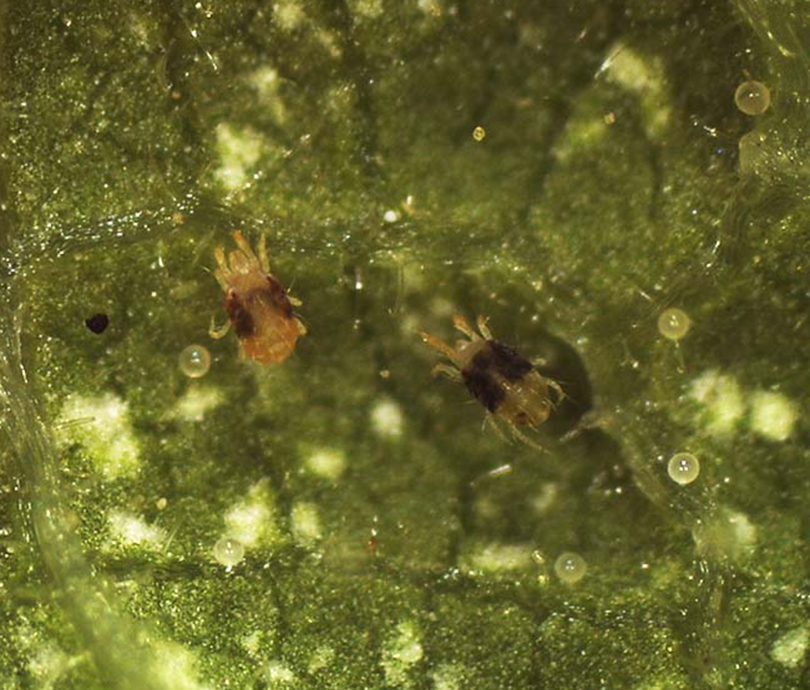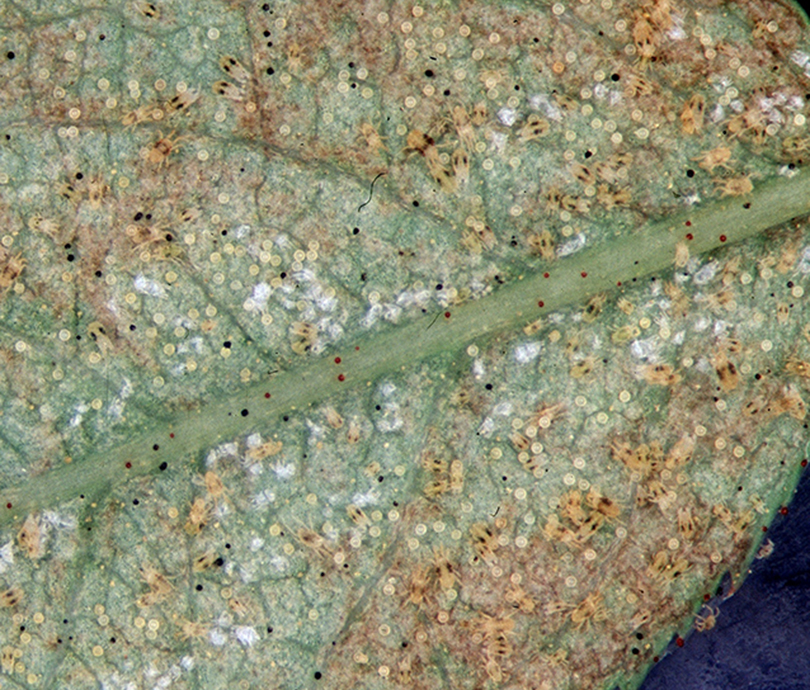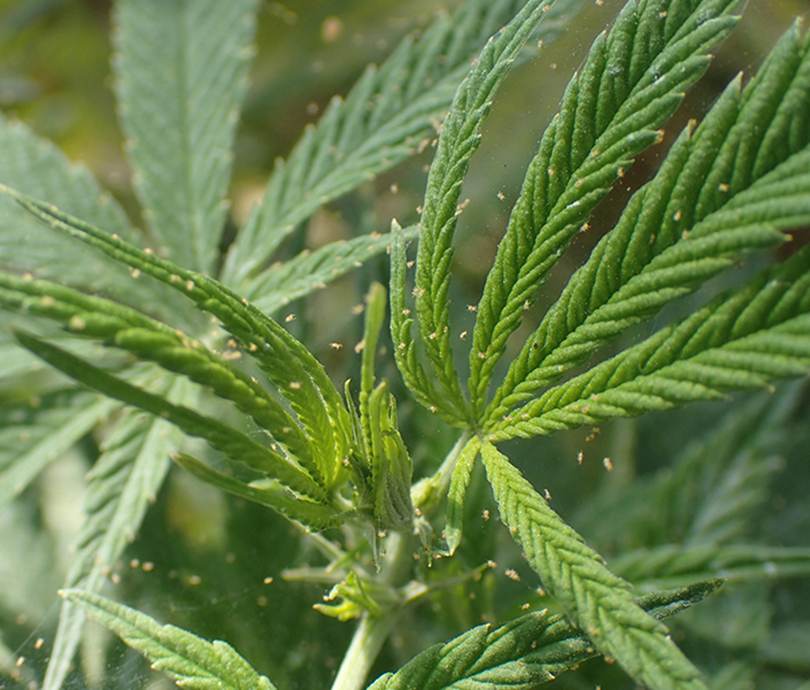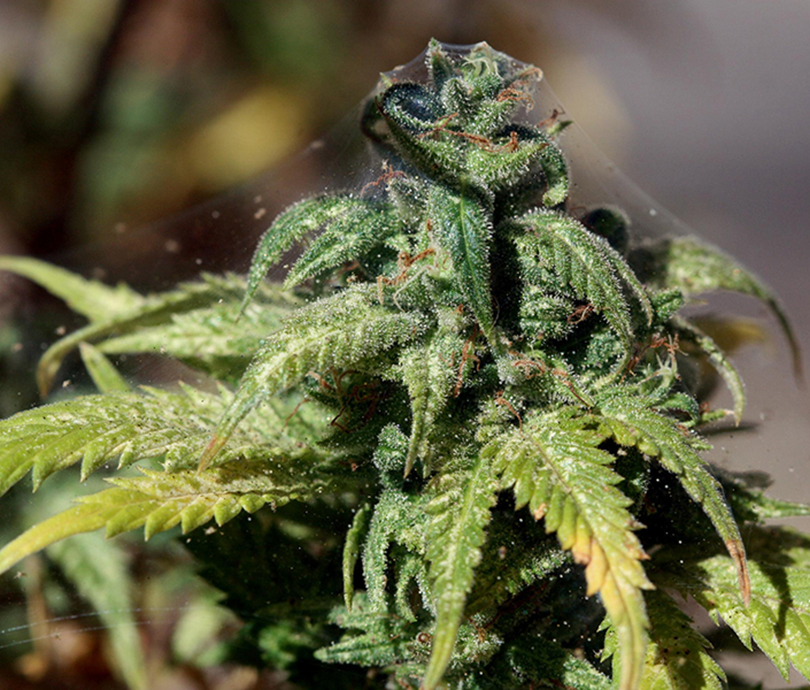Two-Spotted Spider Mite
Tetranychus urtica
 Two-spotted spider mite adults and eggs.
Two-spotted spider mite adults and eggs.

Two-spotted spider mite adults, nymphs, and eggs.
 Two-spotted spider mite feeding damage on hemp (stippling).
Two-spotted spider mite feeding damage on hemp (stippling).
 Two-spotted spider mites and webbing on hemp.
Two-spotted spider mites and webbing on hemp.
Hosts
- Hemp
- Legumes
- Root crops
- Solanaceae crops
- Cucurbits
- Many weeds and ornamentals
Description
Tiny, with a yellowish-clear body and two dark spots on either side of its back. Eggs are very small, spherical, translucent initially, and turn opaque as they age. All life stages most frequently occur on the undersides of leaves.
Life Cycle
Egg | Larva | Nymph | Adult
- 8 or more generations per year.
- Overwinter as adults in ground cover and weed residue.
- Adults become active in spring, feeding on weeds and laying eggs.
Damaging Lifestage(s): Nymph, Adult
Damage Symptoms
Leaves become stippled (small yellow spots) and may turn bronze as infestation increases. Generalized bronzing or reddish discoloration on leaves and stems as infestations progress. Leaf margins, and whole leaves in severe cases, may turn brown and die. Plant vigor may be reduced, and premature leaf drop can occur on heavily infested plants. Plants often appear dirty or dusty, especially when webbing is present.
Time for Concern
Anytime weather conditions are hot and dry.
When and Where to Scout
- Monitor for injury symptoms (leaf stippling) during hot, dry conditions.
- Check the undersides of leaves for tiny black specks of debris and slow-moving mites with a hand lens.
- Shake stems over paper or cloth tray and watch for tiny moving dots (spider mites).
- Webbing and a dirty appearance indicates the presence of heavy populations.
Threat Level
High for indoor-grown hemp and moderate for field-grown hemp.
Occurrence in Utah
Two-spotted spider mites are common in Utah, but have only occasionally been found in field-grown hemp.
Management
- Keep plants healthy; reduce drought stress.
- Prevent dust from settling on foliage as this promotes spider mite survival.
- Approved pesticides are available.
When to Consider Treatment
At first sign of plant damage or when low levels are detected during monitoring. Populations can increase rapidly in hot, dry conditions.
Look-alikes
Predatory mites (but these are fast-moving and pear-shaped); other spider mites, thrips; symptoms resemble leafhopper damage.
Insecticides for Spider Mites
| Utah-Registered Product | Active Ingredient(s) | Notes |
|---|---|---|
| Ancora | Isaria fumosorosea | Toxic to bees |
| Azera Insecticide | azadirachtin | |
| Bayer Advanced NATRIA Insecticidal Soap Ready-To-Use | capsicum oleoresin extract | potassium laurate |
| Bonide All Seasons Horticultural & Dormant Spray Oil Concentrate; Ready to Spray | mineral oil | Greenhouse use only (for commercial). |
| Bonide Rose Rx 3 in 1 Concentrate | clarified hydrophobic extract of neem oil | Greenhouse use only. |
| Botanigard Maxx | pyrethrins | Greenhouse use only. |
| Kopa Insecticidal Soap | potassiums salts of fatty acid | |
| Natural Guard Brand Neem | clarified hydrophobic extract of neem oil | |
| Ortho Tree & Shrub Fruit Tree Spray Concentrate | clarified hydrophobic extract of neem oil | |
| Safer Brand Insect Killing Soap with Seaweed Extract II | potassium salts of fatty acids | |
| Safer Brand Neem Oil Concentrate | clarified hydrophobic extract of neem oil | |
| Safer Brand Yard & Garden Insect Killer II | potassium salts of fatty acids | |
| Trilogy | sulfur | |
| Venerate CG; XC | Burkholderia sp. strain A396 | |
| Whitney Farms Insecticidal Soap | potassium laurate |
Photo Credits
Adults and eggs/Stippling/Mites on hemp - USU Extension IPM Program
Adults, nymphs, and eggs/Webbing/ Damage and webbing - Whitney Cranshaw, Colorado State University, Bugwood.org



